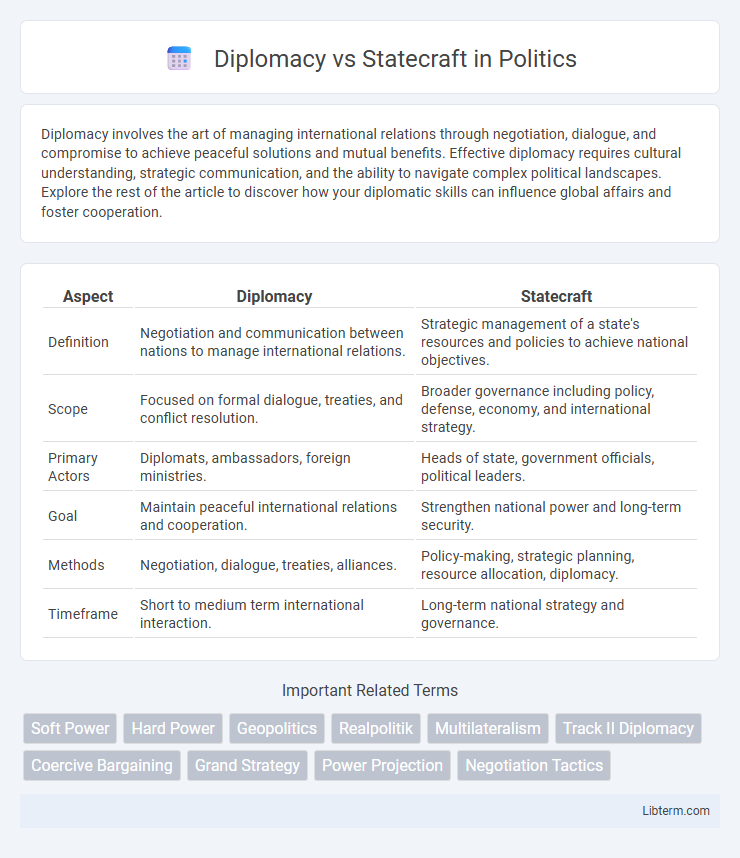Diplomacy involves the art of managing international relations through negotiation, dialogue, and compromise to achieve peaceful solutions and mutual benefits. Effective diplomacy requires cultural understanding, strategic communication, and the ability to navigate complex political landscapes. Explore the rest of the article to discover how your diplomatic skills can influence global affairs and foster cooperation.
Table of Comparison
| Aspect | Diplomacy | Statecraft |
|---|---|---|
| Definition | Negotiation and communication between nations to manage international relations. | Strategic management of a state's resources and policies to achieve national objectives. |
| Scope | Focused on formal dialogue, treaties, and conflict resolution. | Broader governance including policy, defense, economy, and international strategy. |
| Primary Actors | Diplomats, ambassadors, foreign ministries. | Heads of state, government officials, political leaders. |
| Goal | Maintain peaceful international relations and cooperation. | Strengthen national power and long-term security. |
| Methods | Negotiation, dialogue, treaties, alliances. | Policy-making, strategic planning, resource allocation, diplomacy. |
| Timeframe | Short to medium term international interaction. | Long-term national strategy and governance. |
Understanding the Concepts: Diplomacy and Statecraft
Diplomacy involves the practice of managing international relations through negotiation, dialogue, and communication to peacefully resolve conflicts and promote national interests. Statecraft refers to the broader art and science of governing a state, encompassing strategic decision-making, policy formulation, and the effective use of political, military, and economic tools to achieve long-term national objectives. Understanding diplomacy as a component of statecraft highlights the interplay between tactical negotiations and overarching strategic goals in international affairs.
Historical Evolution of Diplomacy and Statecraft
The historical evolution of diplomacy and statecraft traces back to ancient civilizations such as Mesopotamia, Egypt, and China, where early diplomatic protocols and treaties were established to manage inter-state relations. During the Renaissance, the institutionalization of resident ambassadors marked a significant shift, embedding diplomacy as a formal practice within European statecraft. The Peace of Westphalia in 1648 further codified state sovereignty principles, fundamentally shaping modern diplomatic frameworks and the strategic conduct of statecraft in international relations.
Key Differences between Diplomacy and Statecraft
Diplomacy primarily involves communication, negotiation, and relationship-building between states to manage international relations peacefully. Statecraft encompasses a broader set of strategic actions, including policy formulation, power projection, and manipulation of both domestic and international factors to achieve national objectives. The key difference lies in diplomacy being a tool within the wider practice of statecraft, which integrates diplomatic efforts with political, military, and economic strategies.
Major Tools of Diplomacy
Major tools of diplomacy include negotiation, communication channels, cultural exchange, and economic incentives, each designed to manage international relations and resolve conflicts peacefully. Negotiation leverages dialogue to achieve mutually beneficial agreements, while communication channels such as embassies and diplomatic cables facilitate continuous interaction between states. Cultural exchanges and economic incentives foster goodwill and cooperation, promoting soft power influence in global diplomacy.
Core Elements of Statecraft
Statecraft centers on strategic governance skills, including policymaking, resource management, and long-term planning to achieve national objectives. Core elements involve political acumen, negotiation expertise, and the ability to balance internal and external interests effectively. Unlike diplomacy's focus on formal communication and representation, statecraft emphasizes comprehensive control over a nation's political, economic, and military power.
Strategic Approaches in Diplomacy
Strategic approaches in diplomacy prioritize long-term objectives, leveraging negotiation, alliance-building, and information gathering to advance national interests. Effective diplomacy employs a nuanced understanding of geopolitical dynamics, balancing soft power tactics with firm policy stances to achieve sustainable agreements. Statecraft complements this by integrating military, economic, and political tools, but diplomacy remains the primary instrument for managing international relations through dialogue and consensus.
Power Dynamics in Statecraft
Power dynamics in statecraft involve the strategic use and distribution of authority, influence, and resources to achieve national objectives. Unlike diplomacy, which primarily focuses on dialogue and negotiation between states, statecraft incorporates coercive tactics, alliance-building, and realpolitik to maintain or shift balances of power on the global stage. Mastery of power dynamics in statecraft enables a state to assert its interests effectively while navigating complex international relations.
Diplomacy and Statecraft in Practice: Case Studies
Diplomacy in practice involves negotiation, communication, and relationship-building to resolve conflicts and advance national interests, exemplified by the Cuban Missile Crisis where skilled dialogue prevented nuclear war. Statecraft extends beyond diplomacy, incorporating strategic use of power, policy-making, and intelligence, as seen in the British Empire's management of colonial affairs through both diplomatic engagement and coercive measures. Case studies highlight how effective statecraft balances diplomatic tact with practical power application to achieve sustainable political solutions.
Challenges Facing Modern Diplomacy and Statecraft
Modern diplomacy and statecraft face challenges such as cyber threats compromising secure communications, shifting power dynamics due to emerging global actors, and the complexity of multilateral negotiations amid conflicting national interests. The rise of digital diplomacy demands adaptation to social media influence while maintaining confidentiality and trust. Climate change, transnational terrorism, and economic interdependence further complicate traditional diplomatic strategies, requiring innovative approaches to international relations.
The Future of Diplomacy and Statecraft
The future of diplomacy and statecraft increasingly hinges on integrating advanced technologies like artificial intelligence and cyber tools to enhance decision-making and communication efficiency. Emerging global challenges such as climate change, cybersecurity threats, and shifting power dynamics demand adaptable statecraft strategies that emphasize multilateral cooperation. Digital diplomacy platforms and data analytics enable diplomats to engage more effectively with global audiences and anticipate geopolitical trends.
Diplomacy Infographic

 libterm.com
libterm.com